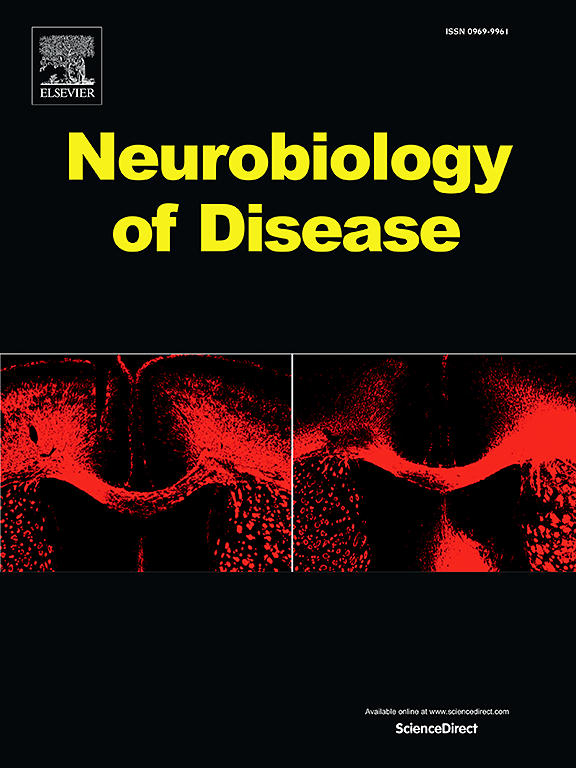有记忆障碍的老年人血浆维生素D与血浆磷酸化tau-181和血浆神经丝轻链的横断面关联
IF 5.6
2区 医学
Q1 NEUROSCIENCES
引用次数: 0
摘要
缺乏维生素D与认知能力下降和阿尔茨海默病有关。因此,我们研究了有记忆障碍的老年人血浆25羟维生素D [25(OH)D]与血浆磷酸化tau 181 (p-tau 181)和神经丝轻链(NfL)之间的关系。方法对“多域阿尔茨海默病预防试验”基线数据进行横断面分析。研究对象是519名70岁以上有痴呆风险的法国社区居民,血浆25(OH)D和血浆p-tau基线数据为181人,311名血浆25(OH)D和血浆NfL基线数据。血浆25(OH)D、p-tau 181和NfL采用高灵敏度免疫法测定,并采用校正回归分析探讨相关性。结果受试者平均(SD)年龄为75.2岁(4.3岁),女性占67.6%。血浆25(OH)D平均(SD)浓度为23.5 ng/ml(11.3)。血浆p-tau 181和血浆NfL的平均(SD)浓度分别为9.9 pg/ml(4.5)和81.1 pg/ml(34.1)。我们没有发现基线血浆25(OH)D和血浆p-tau 181(模型3:β-系数,0.0003,95% CI: - 0.0036, 0.0042, p = 0.879)或血浆25(OH)D和血浆NfL(模型3:β-系数,- 0.0012,95% CI: - 0.0055, 0.0032, p = 0.599)之间的显著横断面关联。年龄、认知状况、性别、心血管风险或载脂蛋白ε4基因型没有改变这些非显著相关性。结论:在老年痴呆高危人群中,血浆25(OH)D与血浆p-tau 181或血浆NfL无关。纵向重复研究是验证这些横断面结果的必要条件。本文章由计算机程序翻译,如有差异,请以英文原文为准。
Cross-sectional associations of plasma vitamin D with plasma phosphorylated tau-181 and plasma neurofilament light chain in older adults with memory complaints
Background
Lack of vitamin D is associated with cognitive decline and Alzheimer's disease. Therefore, we examined the relationship between plasma 25 hydroxyvitamin D [25(OH)D] and plasma phosphorylated-tau 181 (p-tau 181) and neurofilament light chain (NfL) in older adults with memory complaints.
Methods
This is a cross-sectional analysis of ‘Multidomain Alzheimer Preventive Trial’ baseline data. Subjects were 519 French community-dwelling adults aged 70+ years at risk of dementia with baseline data on plasma 25(OH)D and plasma p-tau 181 and 311 individuals with baseline data on plasma 25(OH)D and plasma NfL. Plasma 25(OH)D, p-tau 181 and NfL were measured using high-sensitivity immune-based assays and associations were explored using adjusted regression analyses.
Results
Subjects had a mean (SD) age of 75.2 years (4.3) and 67.6 % were female. The mean (SD) plasma 25(OH)D concentration was 23.5 ng/ml (11.3). The mean (SD) concentrations of plasma p-tau 181 and plasma NfL were 9.9 pg/ml (4.5) and 81.1 pg/ml (34.1) respectively. We did not find significant cross-sectional associations between baseline plasma 25(OH)D and plasma p-tau 181 (Model 3: β-coefficient, 0.0003, 95 % CI: −0.0036, 0.0042, p = 0.879) or plasma 25(OH)D and plasma NfL (Model 3: β-coefficient, −0.0012, 95 % CI: −0.0055, 0.0032, p = 0.599). Age, cognitive status, sex, cardiovascular risk or apolipoprotein ε4 genotype did not modify these non-significant associations.
Conclusions
These findings provide evidence that plasma 25(OH)D is not associated with plasma p-tau 181 or plasma NfL in older adults with heightened dementia risk. Longitudinal replication studies are essential to validate these cross-sectional results.
求助全文
通过发布文献求助,成功后即可免费获取论文全文。
去求助
来源期刊

Neurobiology of Disease
医学-神经科学
CiteScore
11.20
自引率
3.30%
发文量
270
审稿时长
76 days
期刊介绍:
Neurobiology of Disease is a major international journal at the interface between basic and clinical neuroscience. The journal provides a forum for the publication of top quality research papers on: molecular and cellular definitions of disease mechanisms, the neural systems and underpinning behavioral disorders, the genetics of inherited neurological and psychiatric diseases, nervous system aging, and findings relevant to the development of new therapies.
 求助内容:
求助内容: 应助结果提醒方式:
应助结果提醒方式:


